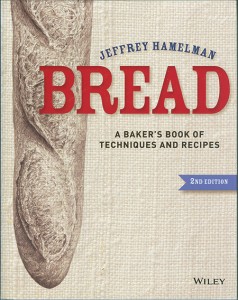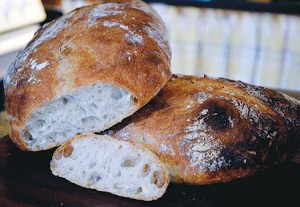
 copyright the Chronicle April 8, 2015
copyright the Chronicle April 8, 2015
Bread: A Baker’s Book of Techniques and Recipes, 2nd Edition, by Jeffrey Hamelman, illustrations and photography by Chiho Kaneko; Published by John Wiley & Sons, Inc., Hoboken, New Jersey, 2014; Hardbound, 478 pages; $45.
Reviewed by Joseph Gresser
For anyone interested in learning to bake good bread or, even better, improving their baking skills, I can unreservedly recommend this book.
I was a lapsed home baker when a good friend gave me a baking book several years ago. The book was useful in some respects, but the recipes were riddled with mistakes, and my return to bread making was nearly cut short.
Fortunately, my friend came to the rescue with the first edition of Mr. Hamelman’s book. His recipes were more carefully edited, and the advice that accompanied them made the process of creating a satisfactory loaf straightforward and pleasurable.
The second edition of the book, which just came out recently, contains additional recipes and corrects an oversight in the first edition. That volume only gave instructions for kneading dough using some kind of electric mixer.
In the new book Mr. Hamelman gives two techniques for making bread by hand, neither of them the traditional method of pushing and pulling the dough. Gentleness with bread is part of his credo and, he says, results in a loaf that looks and tastes better than one that is over kneaded.
My standards are far less stringent than those of Mr. Hamelman who is director of baking and the baking education center at King Arthur Flour in Norwich, but I am glad to have his advice. Even though I am far from producing perfect bread, my repertory has grown and I’m happier with the quality of what emerges from my oven.
While Mr. Hamelman writes in an unintimidating style, his audience is one that includes both professional bakers and people, like me, who turn out a loaf or two every week.
That is evident in the recipes, which have ingredients listed in four formats: U.S. weights, metric weights, home baking (which is a tenth of the amounts in the first two formats, which are in greater quantities for bakers), and baker’s percentage. The last allows a professional baker to quickly scale the recipes up or down as needed.
Measuring according to weight is one of the first points Mr. Hamelman makes in his book. Using a scale, he says, allows for a more consistent dough than is possible by measuring ingredients by volume.
While he offers recipes from all over the bread-baking universe, there are some things most have in common, and which I have not encountered in other bread books.
First Mr. Hamelman often has the baker mix ingredients for wheat breads just enough to form a kind of shaggy dough, nothing like you expect when you think of bread dough. That dough is allowed to rest for between 20 minutes and an hour, for what he calls the autolyse process.
In that time, the flour becomes fully mixed with the water in the recipe and the gluten bonds that give bread its structure develop despite the lack of manipulation.

Often the leavening agent — yeast or sourdough starter — is added after the autolyse period along with the salt.
After another few minutes in the mixer on its second lowest speed, the dough is ready for bulk fermentation. Mr. Hamelman recommends mixing the bread for just a few minutes, enough to let the dough further develop its gluten network.
According to the book, there is a balance that needs to be struck between developing the network so much that the bread will deteriorate during the rising process, and leaving it so weak that it won’t develop the proper structure.
In addition, too much mixing gets so much oxygen into the dough that both the aroma and color of the finished loaf will suffer. The aim is to have a creamy color to the interior of a wheat loaf. Excess oxygenation has the same effect on bread that it does on egg whites, which change from a yellowish color to pure white when they are whipped.
One might ask how somewhat weak, and fairly wet dough can ever end up as decent bread. The answer is in the bulk fermentation process — what we civilians call rising.
Instead of punching the rising dough down every so often, Mr. Hamelman advises turning it out onto a floured table and folding. Excess gas gets gently pressed out during the folding, but amazingly the dough gathers strength as well.
Most recipes call for folding dough twice during the rising process. After bulk fermentation the dough is divided up and shaped into loaves.
This process is tricky and I must admit that despite the very clear illustrations drawn by Mr. Hamelman’s wife, Chiho Kaneko, I haven’t mastered this part of the process.
Nor am I as good at slitting the surface of the loaf with a sharp tool as I would like to be. That cut directs the expansion of the bread into a specific location so it doesn’t end up with uncontrolled cracks in it. When properly done the cut makes an exceedingly scenic loaf.
Once risen, the loaves go into the oven, preferably onto a hot baking stone. Commercial bakers are likely to have a professional oven that can squirt steam into the baking chamber, Mr. Hamelman says.
The idea is to keep the surface of the bread somewhat soft as it rises, so it will expand fully before the crust develops. Mr. Hamelman’s book gives very helpful advice to a home baker trying to achieve similar results.
While the professional baker is looking for the consistent loaves her customers desire, an amateur like me is happy to turn out decent bread every week. My occasional failures are not commercial disasters, just blows to my ego.
One of the great things about Mr. Hamelman’s book is the variety of recipes he offers to the home baker. I’ve made different types of white, rye, whole wheat bread, and bagels following his instructions and the results have been uniformly good, given my skill level.
There are some recipes I haven’t tried, including a really amazing recipe for a Swiss bread that uses only the water in which raisins have been soaked for leavening.
The new book also adds recipes for specialties like brioche, which look like rewarding projects.
Added to this is a detailed explanation of different flour types, useful charts explaining weights and measurements, and a scientific examination of the bread baking process.
While these sections aren’t strictly necessary to one who only wants recipes, I have found absorbing the information has actually helped my bread baking skills.
For me the second edition of Mr. Hamelman’s opus could not have come at a more opportune moment. My copy of the first edition had just started falling apart from over use.
contact Joseph Gresser at [email protected]
For more free articles from the Chronicle like this one, see our Reviews pages. For all the Chronicle’s stories, subscribe:
Print subscription
Annual online subscription
Short-term online subscription







